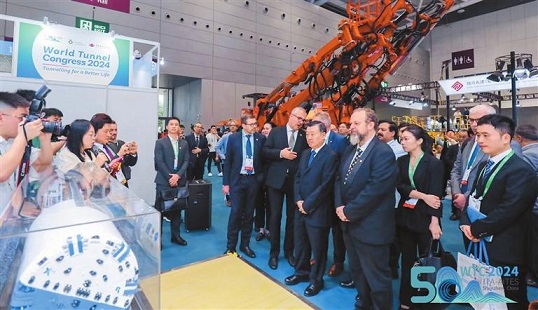Shenzhen
 2024/4/23
2024/4/23
 source: Shenzhen Daily
source: Shenzhen Daily
 Print
Print

Ni Hong (C in the right group), minister of housing and urban-rural development, Michal Mlynár (on Ni’s left), U.N. assistant secretary-general and acting executive director of U.N.-Habitat, and Arnold Dix (on Ni’s right), president of the International Tunneling and Underground Space Association, watch a model of a tunnel shielding machine on display at an exhibition at the Shenzhen World Exhibition and Convention Center in Bao’an District yesterday. The 2024 World Tunnel Congress opened at the center yesterday. The exhibition, covering over 20,000 square meters, showcases the latest technologies and equipment in underground tunneling. Courtesy of the organizers
Han Ximin
1824295095@qq.com
THE 2024 World Tunnel Congress, the world’s largest, most prestigious, and most influential professional meeting in the field of tunnel engineering, opened at the Shenzhen World Exhibition and Convention Center in Bao’an District yesterday. It brought together more than 3,000 experts, scholars, and business representatives from international tunnel and underground space associations and exhibitors from 79 countries and regions.
This is the second time the congress has been hosted in China; the first was 34 years ago in 1990 in Chengdu, the capital of Southwest China’s Sichuan Province.
According to the International Tunneling and Underground Space Association (ITA-AITES) and the China Civil Engineering Society — the organizers — both the scale of the congress and the number of participants hit a record high this year.
In a speech at the opening ceremony yesterday, Michal Mlynár, U.N. assistant secretary-general and acting executive director of U.N.-Habitat, said that the development and utilization of underground space is of great significance to saving surface land resources, building green ecology, and addressing climate change. Mlynár hopes the congress will help strengthen technical exchanges, deepen international cooperation, and promote advances in tunnel and underground engineering construction technology.
Arnold Dix, president of ITA-AITES, praised Shenzhen’s natural and urban environment, commending the significant breakthroughs made in tunnel and underground engineering construction and equipment manufacturing. Dix looks forward to Shenzhen engaging in more scientific and technological innovations and international exchanges.
The congress participants will share ideas at 40 thematic forums and deliver 200 lectures on topics such as geological survey, design innovation, mechanized tunneling, immersed tube tunnels, and the utilization of underground space.
The congress will arrange for the participants to visit and inspect key tunnel projects in Shenzhen like the Shenzhen-Zhongshan Link, the Pearl River Tunnel of Shenzhen- Jiangmen High-speed Railway, the Huangmugang Comprehensive Transportation Hub, the Qianhai-Huanggang Checkpoint section of the Guangzhou-Dongguan-Shenzhen Intercity Rail, and the Qianhai International Hub Center.
A series of world-leading technological breakthroughs in areas such as underwater tunnels, underground stations, and shield tunnel construction have been made in Shenzhen’s tunnel engineering projects, according to Shenzhen Mayor Qin Weizhong.
The Shenzhen-Zhongshan Link, scheduled to open this June, has the world’s first two-way eight-lane sunken tube tunnel. The Mawan Cross-sea Passage, Shenzhen’s first underwater tunnel, features the largest diameter subsea shield tunnel in China. The Binhai Avenue underpass won the prestigious International Tunnel Association’s 2023 Engineering Excellence Award.
So far, Shenzhen has built 1,300 kilometers of tunnels. Its Metro network, which has reached 567 kilometers in length, ranks first in China in terms of density.





